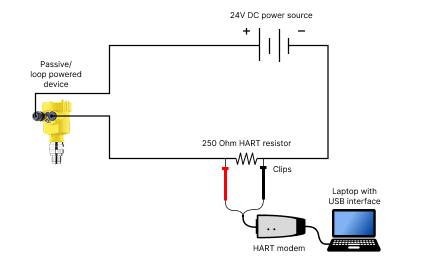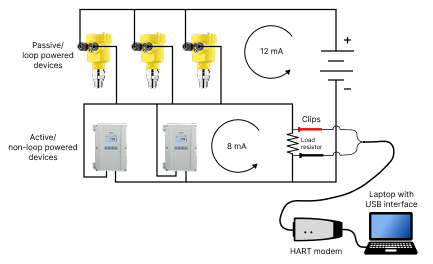Cassette tapes, OS2, MicoVAX, and HART: all products of the 1980s, yet only one has survived the test of time.
HART, or Highway Addressable Remote Transducer, is an industrial protocol that dates back to the mid-80s. Having been in the marketplace for so long, HART has gained a number of myths over the years. As with all myths, there is some truth to them, and, of course, some error. Let’s take a look at a few of the most prevalent HART myths.
Myth 1: You can use any wire and power supply and it will just work.
At JCOM Automation we talk to many customers who have done that and found that it does just work. This is especially true if they are wired into a HART input or output card and only going a short distance. However, we also talk with a fair number of people who do run into problems.
The truth is that for HART communications to work, you need:
- Minimum loop resistance of 250 ohms
- Resistance Capacitance (RC) value of the network of 65 μs or less
- Be able to meet the HART specification on the power supply
If you are using a HART input or output card, then the so-called HART resistor is built into the card. If your run is short (less than 100 meters) and you are using typical instrument-grade wire, then the RC value of the network will be under 65 μs. Most industrial power supplies meet the HART power supply specification. (see our full line of HART devices)
Customers missing the HART resistor are our most frequent technical support calls. If the wire distance is less than 100 meters, then, typically, just adding a 250 ohm resistor will get HART communications going.

When the network is long or you are using multi-drop, then you really need to calculate the RC value of the network and verify that it is 65 μs or less. This forms an upper limit on the loop resistance. For longer runs, sometimes the value of the HART resistor has to be lowered for HART communications to work.
Using a power supply that does not meet the HART specification is rare but has happened. The requirements are:
- Maximum ripple (47 to 125 Hz) = 0.2 V p-p
- Ensure the maximum noise (500 Hz to 10 kHz) = 1.2 mV rms
- Maximum series impedance (500 Hz to 10 kHz) = 10 ohm
The impact of the wire comes in two ways. First, it’s capacitive and resistance values will certainly affect the RC value. Second, it needs to have a good shield on it and it should be grounded. This will protect communications from electromagnetic interference.
Myth 2: HART is so simple that you do not have to ‘design’ the network.
Well, if going point-to-point and the distance from the HART input/output card to the device is less than 100 meters, then this is true.
As we discussed above, if you are (a) using a HART input/output card, (b) going under 100 meters, and (c) using good shield instrument-grade wire grounding at one end, then it will work. As it turns out, this is the most common situation. However, if the runs are long, and/or multi-drop topology is being used, then you will need to ‘design’ the network.
Myth 3: You would never want to multi-drop HART.
The truth of this myth really depends on how fast the data is needed. HART multi-drop is very slow. To control a process, if you need to know that the value (level, temperature, flow, pressure, valve position) has changed in the last ½ second, then you would not want to use HART multi-drop. However, if you are simply monitoring slow-moving variables, then this can work and there can be a real cost savings in wiring and components by using HART multi-drop.
When HART is multi-dropped, the analog channel cannot be used so all communications must go through the digital channel. The digital channel runs at 1200 bits per second and has a throughput of around two to three messages per second. If two instruments are multi-dropped, the process variables are updated every second. If eight instruments are multi-dropped, the process variables are updated every four seconds.
One challenge in using multi-drop is in the design. Calculating the loop resistance and the RC value of the network is no longer a trivial calculation – and it is not optional. This is an application where the network has to be designed and components chosen carefully.
Saying that you would never want to multi-drop HART, then, isn’t necessarily true, depending on these variables. If the application works, using HART multi-drop provides an advantage in capital cost savings on wires and components.

Myth 4: HART devices have fewer diagnostics than other protocols.
The truth is that HART has a very simple way to report diagnostics and does not force vendors into having detailed diagnostics. However, vendors can still put in as many diagnostics as they would like.
Most HART instruments do not have a way to alert the master that they have diagnostics information. In newer HART 7 devices there is a way, but the vast majority of HART devices currently out in the field do not. What this means is that the system integrator has to set up the system to go out every so often and ask the instruments if they have any diagnostics. Once the master knows that there is information, it can go out and get it, just like any other protocol.
The amount of diagnostics in a HART instrument varies greatly from vendor to vendor. Many vendors have basic diagnostics in their HART instruments and then put more advanced diagnostics in their PROFIBUS or Foundation Fieldbus instruments.
Myth 5: The HART protocol is old-fashioned and will soon fade from our modern world
The truth is that the HART protocol has been around for a very long time, because it fills a market need. It is very widespread and has a large installed basis. The protocol itself has not stagnated. It is constantly being improved and expanded. WirelessHART is the perfect example of this expansion where its competitors Profibus and Foundation Fieldbus have even adopted its use for wireless applications. HART has done this while maintaining all of its interoperability and backward compatibility at the same time. The end result of this is that the use of HART is still growing.
Summary:
HART is a long-standing protocol with a history all of its own. The nuggets of truth we found in these HART myths include:
- On short runs, any industrial-grade communication wire will work and most industrial power supplies work very well.
- HART is easy to use – in many cases you do not even need to design the network.
- In many applications you would not want to use HART multi-drop.
- Many HART devices do have fewer diagnostics than other protocols.
However, we also learned that:
- Wire and power supply do matter.
- There are design rules and sometimes you need to use them.
- For some applications, HART multi-drop will work well and can provide real cost savings.
- Some manufacturers have nearly the same diagnostics in their HART instruments as they do in their PROFIBUS or Foundation Fieldbus devices. End users do not have to use the more advanced protocols to get the advanced features.
A decade ago, industry experts were saying that HART was on its way out. Today, it is very clear that HART is here to stay. It is a useful protocol, but end users still need to be educated to get its full value. HART is not just still up-to-date it’s even future-proof.
James Powell has a great primer for understanding HART networks “HART communication protocol: a practical guide“. Get your copy from Amazon
If you want to know more about HART take our training course “HART, SIMATIC PDM, PACTware maintenance course“. Click here for more information
JCOM Automation has a great line-up of HART modems and gateways for sale. Click here for more information.
